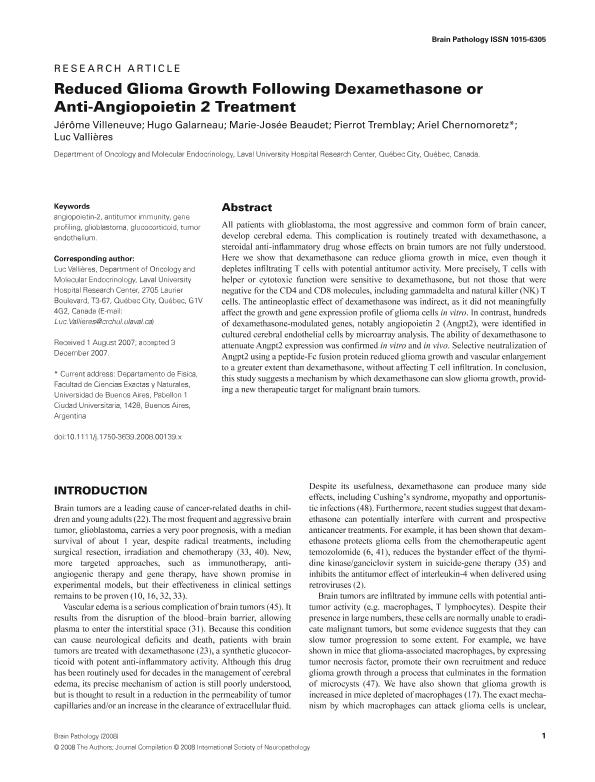Mostrar el registro sencillo del ítem
dc.contributor.author
Villeneuve, Jérôme
dc.contributor.author
Galarneau, Hugo
dc.contributor.author
Beaudet, Marie Josée
dc.contributor.author
Tremblay, Pierrot
dc.contributor.author
Chernomoretz, Ariel

dc.contributor.author
Vallières, Luc
dc.date.available
2018-10-11T14:28:40Z
dc.date.issued
2008-07
dc.identifier.citation
Villeneuve, Jérôme; Galarneau, Hugo; Beaudet, Marie Josée; Tremblay, Pierrot; Chernomoretz, Ariel; et al.; Reduced glioma growth following dexamethasone or anti-angiopoietin 2 treatment; Wiley Blackwell Publishing, Inc; Brain Pathology; 18; 3; 7-2008; 401-414
dc.identifier.issn
1015-6305
dc.identifier.uri
http://hdl.handle.net/11336/62173
dc.description.abstract
All patients with glioblastoma, the most aggressive and common form of brain cancer, develop cerebral edema. This complication is routinely treated with dexamethasone, a steroidal anti-inflammatory drug whose effects on brain tumors are not fully understood. Here we show that dexamethasone can reduce glioma growth in mice, even though it depletes infiltrating T cells with potential antitumor activity. More precisely, T cells with helper or cytotoxic function were sensitive to dexamethasone, but not those that were negative for the CD4 and CD8 molecules, including gammadelta and natural killer (NK) T cells. The antineoplastic effect of dexamethasone was indirect, as it did not meaningfully affect the growth and gene expression profile of glioma cells in vitro. In contrast, hundreds of dexamethasone-modulated genes, notably angiopoietin 2 (Angpt2), were identified in cultured cerebral endothelial cells by microarray analysis. The ability of dexamethasone to attenuate Angpt2 expression was confirmed in vitro and in vivo. Selective neutralization of Angpt2 using a peptide-Fc fusion protein reduced glioma growth and vascular enlargement to a greater extent than dexamethasone, without affecting T cell infiltration. In conclusion, this study suggests a mechanism by which dexamethasone can slow glioma growth, providing a new therapeutic target for malignant brain tumors. © 2008 The Authors.
dc.format
application/pdf
dc.language.iso
eng
dc.publisher
Wiley Blackwell Publishing, Inc

dc.rights
info:eu-repo/semantics/openAccess
dc.rights.uri
https://creativecommons.org/licenses/by-nc-nd/2.5/ar/
dc.subject
Angiopoietin-2
dc.subject
Antitumor Immunity
dc.subject
Gene Profiling
dc.subject
Glioblastoma
dc.subject
Glucocorticoid
dc.subject
Tumor Endothelium
dc.subject.classification
Otras Ciencias Biológicas

dc.subject.classification
Ciencias Biológicas

dc.subject.classification
CIENCIAS NATURALES Y EXACTAS

dc.title
Reduced glioma growth following dexamethasone or anti-angiopoietin 2 treatment
dc.type
info:eu-repo/semantics/article
dc.type
info:ar-repo/semantics/artículo
dc.type
info:eu-repo/semantics/publishedVersion
dc.date.updated
2018-10-05T19:11:13Z
dc.journal.volume
18
dc.journal.number
3
dc.journal.pagination
401-414
dc.journal.pais
Reino Unido

dc.journal.ciudad
Londres
dc.description.fil
Fil: Villeneuve, Jérôme. Laval University; Canadá
dc.description.fil
Fil: Galarneau, Hugo. Laval University; Canadá
dc.description.fil
Fil: Beaudet, Marie Josée. Laval University; Canadá
dc.description.fil
Fil: Tremblay, Pierrot. Laval University; Canadá
dc.description.fil
Fil: Chernomoretz, Ariel. Consejo Nacional de Investigaciones Científicas y Técnicas. Oficina de Coordinación Administrativa Ciudad Universitaria. Instituto de Física de Buenos Aires. Universidad de Buenos Aires. Facultad de Ciencias Exactas y Naturales. Instituto de Física de Buenos Aires; Argentina
dc.description.fil
Fil: Vallières, Luc. Laval University; Canadá
dc.journal.title
Brain Pathology

dc.relation.alternativeid
info:eu-repo/semantics/altIdentifier/doi/https://dx.doi.org/10.1111/j.1750-3639.2008.00139.x
dc.relation.alternativeid
info:eu-repo/semantics/altIdentifier/url/https://onlinelibrary.wiley.com/doi/abs/10.1111/j.1750-3639.2008.00139.x
Archivos asociados
